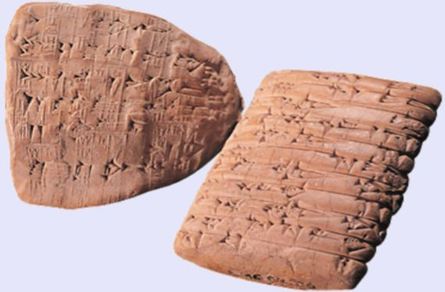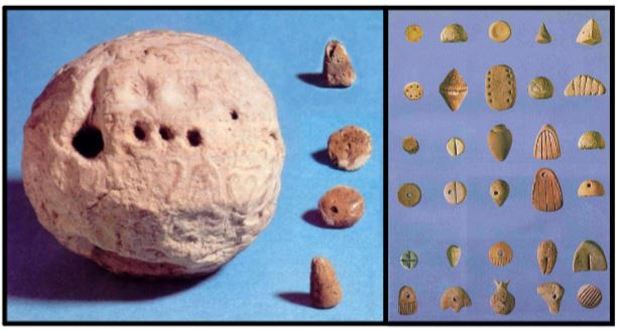Mesopotamia Cuneiform

Essential Themes:
4. Technology: How does technology affect people's lives?
7. Culture: How do we know what we know about human history?
Mesopotamian Inventions
In addition to creating the first civilization, the Mesopotamians invented all sorts of things that are still in use today. Among other things, the ancient Mesopotamians invented the wheel, the sailboat, the first written language, frying pans, razors, cosmetic sets, shepherd’s pipes, harps, kilns to cook bricks and pottery, bronze hand tools like hammers and axes, the plow, the plow seeder, a working pump and, believe it or not, the first battery.
4. Technology: How does technology affect people's lives?
7. Culture: How do we know what we know about human history?
Mesopotamian Inventions
In addition to creating the first civilization, the Mesopotamians invented all sorts of things that are still in use today. Among other things, the ancient Mesopotamians invented the wheel, the sailboat, the first written language, frying pans, razors, cosmetic sets, shepherd’s pipes, harps, kilns to cook bricks and pottery, bronze hand tools like hammers and axes, the plow, the plow seeder, a working pump and, believe it or not, the first battery.
How did early inventions lead to civilization?
 The invention of the "scratch plow" in Mesopotamia 6000 years ago substituted animal power for human muscle and revolutionized agriculture.
The invention of the "scratch plow" in Mesopotamia 6000 years ago substituted animal power for human muscle and revolutionized agriculture.
Many of these early inventions helped drive the need for specialized workers. By increasing the demand for labor, early inventions directly influenced the growth of cities and, therefore, the growth of their civilization. Before potter's wheels were invented, Mesopotamian potters had to make each pot by coiling together individual strands of clay. That was a lengthy and labor intensive process. The potter's wheel made it easier for Mesopotamian potters to create surpluses to trade for other goods or services.
Historians think that the invention of the wheel, the kind used on carts and wagons, was modeled after the potter's wheel. Wheels placed on carts helped farmers get their surpluses to market more easily and more quickly. Farmers also used wagons to transport goods over longer distances. Travel by water was still more efficient, however, so Mesopotamians invented the sailboat.
Even with all of these great inventions, the Mesopotamian invention most important to future civilizations, was the creation of a written language.
Historians think that the invention of the wheel, the kind used on carts and wagons, was modeled after the potter's wheel. Wheels placed on carts helped farmers get their surpluses to market more easily and more quickly. Farmers also used wagons to transport goods over longer distances. Travel by water was still more efficient, however, so Mesopotamians invented the sailboat.
Even with all of these great inventions, the Mesopotamian invention most important to future civilizations, was the creation of a written language.
The first pottery was made by coiling strands of clay one on top of the other (far left). This method , however, resulted in pots of non - uniform shapes and inconsistent wall thickness. The pottery wheel resulted in both sturdier and more beautiful pottery, as well as one of the first examples of "specialized jobs." It's believed that the potters wheel and the first wheels used for transportation were invented in Mesopotamia at roughly the same time, about 6000 years ago.
What is cuneiform?

Cuneiform
The ancient Sumerians developed a written language called cuneiform. Cuneiform began as pictographs, pictures of things that acted as words. Pictographs worked, but they were rather cumbersome. Soon, the clever ancient Sumerians started to use wedge-shaped symbols for objects and ideas instead of pictures. Today, we call this written language of wedge-shaped symbols cuneiform.
We know a great deal about ancient Sumerian civilization from the written records they left behind in stone and clay. The ancient Sumerians kept excellent records and lists of things. They listed their household goods. They listed their court activity. They listed their sales and purchases. They even kept a list of their kings that was updated from time to time as new kings came to power.
One of the best things the Sumerians wrote down was a great story called The Epic of Gilgamesh. The Epic of Gilgamesh is perhaps the oldest recorded story in the world. It tells about the adventures of a king of Uruk, one of the city-states in ancient Sumer. King Gilgamesh may actually have existed. His name is on the list of Sumerian kings, a list we know about because the ancient Sumerians wrote it down.
Cuneiform became a written language as early as 5000 BCE. As the civilization of Sumer started to decline, other civilizations adapted the symbols created by the Sumerians and continued to use cuneiform. Thanks to the Sumerians' great invention, we now also know a great deal about the ancient Mesopotamian civilizations of Babylon and Assyria.
Although cuneiform was used for many thousands of years, and many things have been discovered written in cuneiform, it is still not easy to read. It is not easy to read because the shape of cuneiform letters and the meanings of various cuneiform symbols changed over time and varied by region.
The ancient Sumerians developed a written language called cuneiform. Cuneiform began as pictographs, pictures of things that acted as words. Pictographs worked, but they were rather cumbersome. Soon, the clever ancient Sumerians started to use wedge-shaped symbols for objects and ideas instead of pictures. Today, we call this written language of wedge-shaped symbols cuneiform.
We know a great deal about ancient Sumerian civilization from the written records they left behind in stone and clay. The ancient Sumerians kept excellent records and lists of things. They listed their household goods. They listed their court activity. They listed their sales and purchases. They even kept a list of their kings that was updated from time to time as new kings came to power.
One of the best things the Sumerians wrote down was a great story called The Epic of Gilgamesh. The Epic of Gilgamesh is perhaps the oldest recorded story in the world. It tells about the adventures of a king of Uruk, one of the city-states in ancient Sumer. King Gilgamesh may actually have existed. His name is on the list of Sumerian kings, a list we know about because the ancient Sumerians wrote it down.
Cuneiform became a written language as early as 5000 BCE. As the civilization of Sumer started to decline, other civilizations adapted the symbols created by the Sumerians and continued to use cuneiform. Thanks to the Sumerians' great invention, we now also know a great deal about the ancient Mesopotamian civilizations of Babylon and Assyria.
Although cuneiform was used for many thousands of years, and many things have been discovered written in cuneiform, it is still not easy to read. It is not easy to read because the shape of cuneiform letters and the meanings of various cuneiform symbols changed over time and varied by region.
What was the earliest form of Mesopotamian writing?
|
When archaeologists find ancient cuneiform script, they are always excited about it. But, they need time to translate it to discover if they have found a household list of repaired items, or a new poem or story. There is much yet to be discovered about these ancient people as archaeologists continue to translate the ancient written language of Cuneiform.
|
|
|
|


